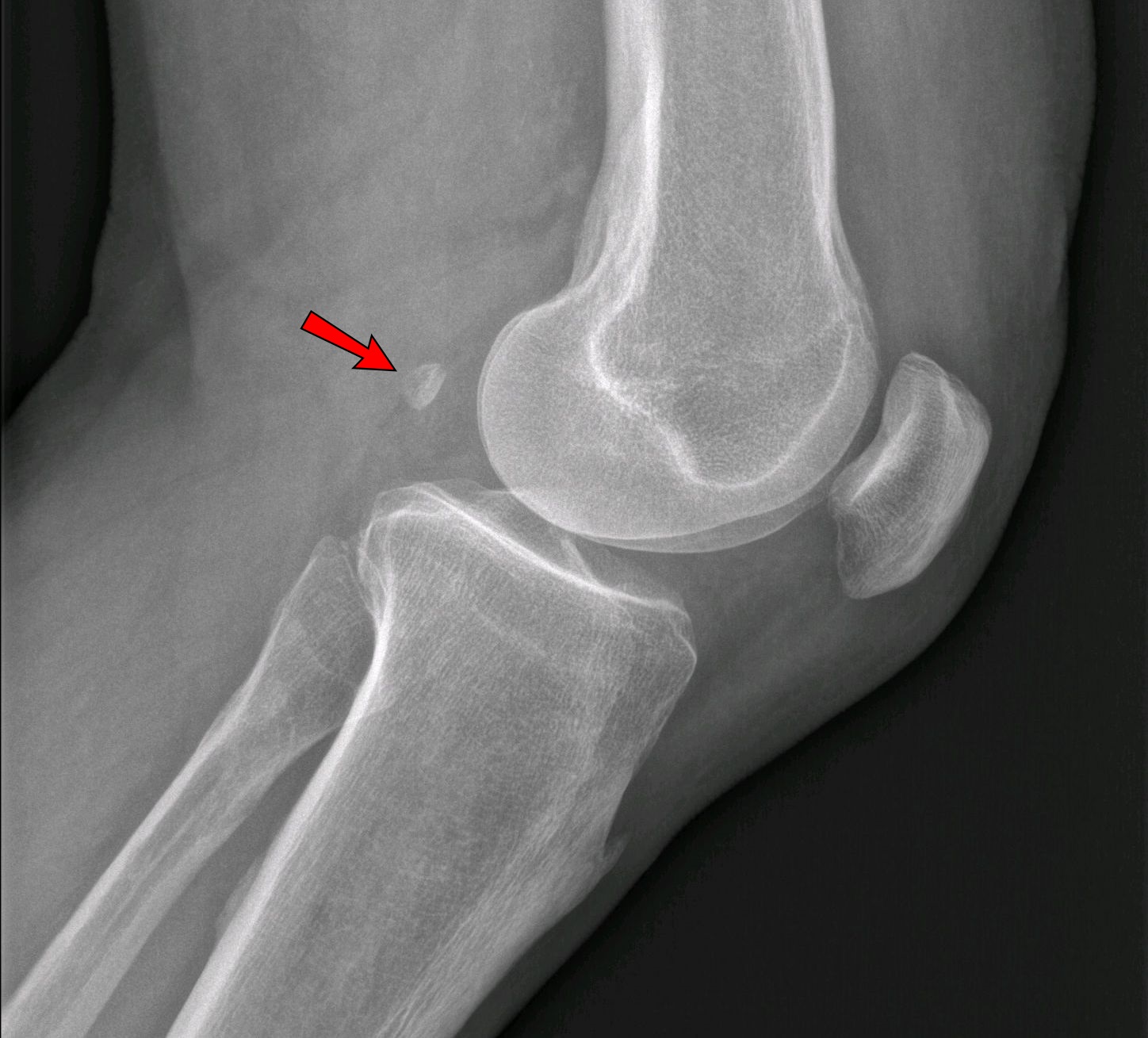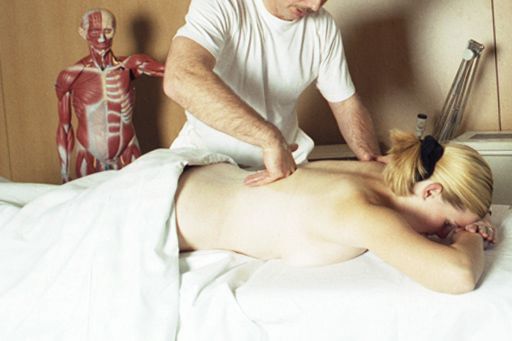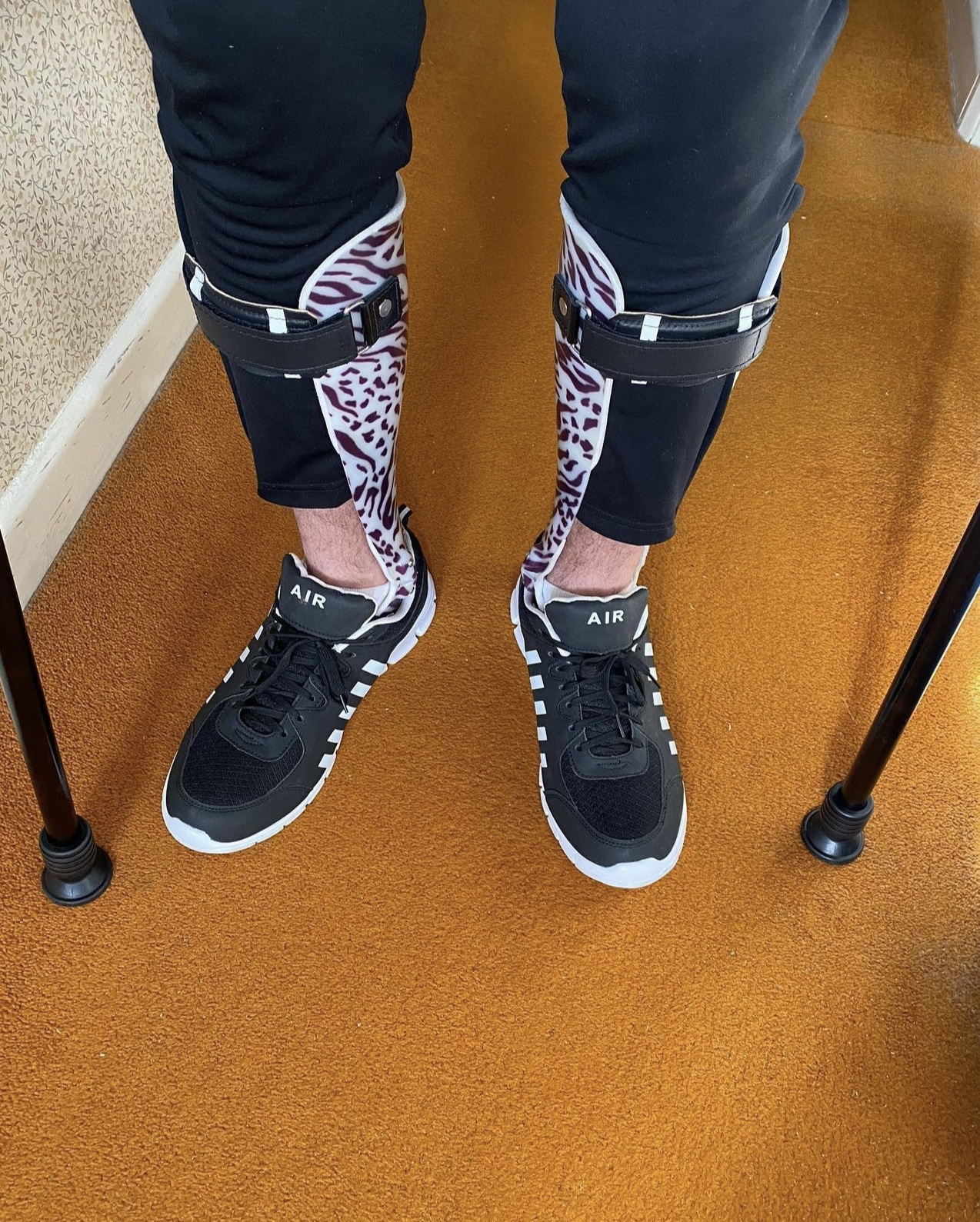|
Accessory Navicular Bone
An accessory navicular bone is an accessory bone of the foot that occasionally develops abnormally in front of the ankle towards the inside of the foot. This bone may be present in approximately 2-14% of the general population and is usually asymptomatic. When it is symptomatic, surgery may be necessary. Accessory navicular bone may cause a continuous stretch and stress on the tibialis posterior tendon which can progress to chronic disabling pain and may cause tendon rupture or secondary flat foot deformity; when this occurs this condition is commonly known as accessory navicular syndrome. Other conditions which closely mimic the symptoms of an accessory navicular bone include plantar fasciitis, bunions and heel spurs. Classification The Geist classification divides the accessory navicular bones into three types. * Type 1: An os tibiale externum is a 2–3 mm sesamoid bone in the distal posterior tibialis tendon. Usually asymptomatic. * Type 2: Triangular or heart-shaped os ... [...More Info...] [...Related Items...] OR: [Wikipedia] [Google] [Baidu] |
Accessory Bone
An accessory bone or supernumerary bone is a bone that is not normally present in the body, but can be found as a anatomical variation, variant in a significant number of people. It poses a risk of being misdiagnosis, misdiagnosed as bone fractures on radiography. Wrist and hand Os ulnostyloideum The ''os ulnostyloideum'' is an ulnar styloid process that is not fused to the rest of the ulna bone.R. O'Rahilly. ''A survey of carpal and tarsal anomalies.'' J Bone Joint Surg Am. 1953; 35: 626–642 On X-rays, an ''os ulnostyloideum'' is sometimes mistaken for an avulsion fracture of the styloid process. However, the distinction between these is extremely difficult.T.E. Keats, M.W. Anderson. ''Atlas of normal roentgen variants that may simulate disease''. 7th edition, Mosby Inc. 2001 It is alleged that the os ulnostyloideum has a close relationship with or is synonymous with the os triquetrum secundarium. Os centrale The ''os carpi centrale'' (also briefly ''os centrale'') i ... [...More Info...] [...Related Items...] OR: [Wikipedia] [Google] [Baidu] |
Ankle
The ankle, the talocrural region or the jumping bone (informal) is the area where the foot and the leg meet. The ankle includes three joints: the ankle joint proper or talocrural joint, the subtalar joint, and the inferior tibiofibular joint. The movements produced at this joint are dorsiflexion and plantarflexion of the foot. In common usage, the term ankle refers exclusively to the ankle region. In medical terminology, "ankle" (without qualifiers) can refer broadly to the region or specifically to the talocrural joint. The main bones of the ankle region are the talus bone, talus (in the foot), the tibia, and fibula (both in the leg). The talocrural joint is a Synovial joint, synovial hinge joint that connects the distal ends of the tibia and fibula in the lower limb with the proximal end of the talus. The articulation between the tibia and the talus bears more weight than that between the smaller fibula and the talus. Structure Region The ankle region is found at the junction ... [...More Info...] [...Related Items...] OR: [Wikipedia] [Google] [Baidu] |
Plantar Fasciitis
Plantar fasciitis or plantar heel pain is a disorder of the plantar fascia, which is the connective tissue that supports the Arches of the foot, arch of the foot. It results in pain in the heel and Sole (foot), bottom of the foot that is usually most severe with the first steps of the day or following a period of rest. Pain is also frequently brought on by dorsiflexion, bending the foot and toes up towards the shin. The pain typically comes on gradually, and it affects both feet in about one-third of cases. The cause of plantar fasciitis is not entirely clear. Risk factors include overuse, such as from long periods of standing, an increase in exercise, and obesity. It is also associated with pronation of the foot, inward rolling of the foot, a tight Achilles tendon, and a sedentary lifestyle. It is unclear if calcaneal spur, heel spurs have a role in causing plantar fasciitis even though they are commonly present in people who have the condition. Plantar fasciitis is a disorder ... [...More Info...] [...Related Items...] OR: [Wikipedia] [Google] [Baidu] |
Bunion
A bunion, also known as hallux valgus, is a deformity of the metatarsophalangeal joint, MTP joint connecting the big toe to the foot. The big toe often bends towards the other toes and the joint becomes red and painful. The onset of bunions is typically gradual. Complications may include bursitis or arthritis. The exact cause is unclear. Proposed factors include wearing overly tight shoes, high-heeled shoes, family history, and rheumatoid arthritis. Diagnosis is generally based on symptoms and supported by radiographs, X-rays. A similar condition of the little toe is referred to as a bunionette. Treatment may include proper shoes, orthotics, or NSAIDs. If this is not effective for improving symptoms, surgery may be performed. It affects about 23% of adults. Females are affected more often than males. Usual age of onset is between 20 and 50 years old. The condition also becomes more common with age. It was first clearly described in 1870. Archaeology, Archaeologists have iden ... [...More Info...] [...Related Items...] OR: [Wikipedia] [Google] [Baidu] |
Heel Spur
A calcaneal spur (also known as a heel spur) is a bony outgrowth from the calcaneal tuberosity (heel bone). Calcaneal spurs are typically detected by Radiography, x-ray examination. It is a form of exostosis. When a foot is exposed to constant Stress (mechanics), stress, calcium deposits build up on the bottom of the heel bone. Generally, this has no effect on a person's daily life. However, repeated damage can cause these deposits to pile up on each other, causing a spur-shaped deformity, called a calcaneal (or heel) spur. An inferior calcaneal spur is located on the inferior aspect of the calcaneus and is typically a response to plantar fasciitis over a period, but may also be associated with ankylosing spondylitis (typically in children). A posterior calcaneal spur develops on the back of the heel at the insertion of the Achilles tendon. An inferior calcaneal spur consists of a calcification of the calcaneus, which lies superior to the plantar fascia at the insertion of the pl ... [...More Info...] [...Related Items...] OR: [Wikipedia] [Google] [Baidu] |
Orthopedic Boot
An orthopedic boot is used for the treatment of injuries of the foot or ankle. Along with orthopedic casts, leg braces, splints and orthotics, they can immobilize and shift weight bearing to help treat injuries to the foot area. Varieties include the ''controlled ankle motion walking boot'' (or ''controlled ankle movement walking boot'', ''below knee walking boot'', ''CAM boot'', ''CAM walker'', or ''moon boot''), an orthopedic device prescribed for the treatment and stabilization of severe sprains, fractures, and tendon or ligament tears in the ankle or foot. In situations where ankle motion but not weight is to be limited, it may be used in place of a cast Cast may refer to: Music * Cast (band), an English alternative rock band * Cast (Mexican band), a progressive Mexican rock band * The Cast, a Scottish musical duo: Mairi Campbell and Dave Francis * ''Cast'', a 2012 album by Trespassers William .... Description A walking boot consists of: *An inner lining, usually ... [...More Info...] [...Related Items...] OR: [Wikipedia] [Google] [Baidu] |
Nonsteroidal Anti-inflammatory Drugs
A nonsteroidal compound is a drug that is not a steroid nor a steroid derivative. Nonsteroidal anti-inflammatory drugs (NSAIDs) are distinguished from corticosteroids as a class of anti-inflammatory agents. List of nonsteroidal steroid receptor modulators Examples include the following: * Estrogens: benzestrol, bifluranol, estrobin, estrobin (DBE), diethylstilbestrol, diethylstilbestrol (stilbestrol), dienestrol, erteberel, fosfestrol, hexestrol, hexestrol (dihydroxystilbestrol), methallenestril, methestrol, methestrol dipropionate, paroxypropione, prinaberel, and triphenylethylene, as well as many xenoestrogens * : acolbifene, afimoxifene, arzoxifene, bazedoxifene, broparestrol, chlorotrianisene, clomifene, clomifenoxide, cyclofenil, droloxifene, enclomifene, endoxifen, ethamoxytriphetol, fispemifene, idoxifene, lasofoxifene, levormeloxifene, miproxifene, nafoxidine, nitromifene, ormeloxifene, ospemifene, panomifene, pipendoxifene, raloxifene, tamoxifen, toremifene, trioxifene, zind ... [...More Info...] [...Related Items...] OR: [Wikipedia] [Google] [Baidu] |
Steroids
A steroid is an organic compound with four fused rings (designated A, B, C, and D) arranged in a specific molecular configuration. Steroids have two principal biological functions: as important components of cell membranes that alter membrane fluidity; and as signaling molecules. Examples include the lipid cholesterol, sex hormones estradiol and testosterone, anabolic steroids, and the anti-inflammatory corticosteroid drug dexamethasone. Hundreds of steroids are found in fungi, plants, and animals. All steroids are manufactured in cells from a sterol: cholesterol (animals), lanosterol ( opisthokonts), or cycloartenol (plants). All three of these molecules are produced via cyclization of the triterpene squalene. Structure The steroid nucleus ( core structure) is called gonane (cyclopentanoperhydrophenanthrene). It is typically composed of seventeen carbon atoms, bonded in four fused rings: three six-member cyclohexane rings (rings A, B and C in the first illus ... [...More Info...] [...Related Items...] OR: [Wikipedia] [Google] [Baidu] |
Inflammation
Inflammation (from ) is part of the biological response of body tissues to harmful stimuli, such as pathogens, damaged cells, or irritants. The five cardinal signs are heat, pain, redness, swelling, and loss of function (Latin ''calor'', ''dolor'', ''rubor'', ''tumor'', and ''functio laesa''). Inflammation is a generic response, and therefore is considered a mechanism of innate immunity, whereas adaptive immunity is specific to each pathogen. Inflammation is a protective response involving immune cells, blood vessels, and molecular mediators. The function of inflammation is to eliminate the initial cause of cell injury, clear out damaged cells and tissues, and initiate tissue repair. Too little inflammation could lead to progressive tissue destruction by the harmful stimulus (e.g. bacteria) and compromise the survival of the organism. However inflammation can also have negative effects. Too much inflammation, in the form of chronic inflammation, is associated with variou ... [...More Info...] [...Related Items...] OR: [Wikipedia] [Google] [Baidu] |
Physical Therapy
Physical therapy (PT), also known as physiotherapy, is a healthcare profession, as well as the care provided by physical therapists who promote, maintain, or restore health through patient education, physical intervention, disease prevention, and health promotion. Physical therapist is the term used for such professionals in the United States, and physiotherapist is the term used in many other countries. The career has many specialties including musculoskeletal, orthopedics, cardiopulmonary, neurology, endocrinology, sports medicine, geriatrics, pediatrics, women's health, wound care and electromyography. PTs practice in many settings, both public and private. In addition to clinical practice, other aspects of physical therapy practice include research, education, consultation, and health administration. Physical therapy is provided as a primary care treatment or alongside, or in conjunction with, other medical services. In some jurisdictions, such as the United Kin ... [...More Info...] [...Related Items...] OR: [Wikipedia] [Google] [Baidu] |
Orthotics
Orthotics () is a medical specialty that focuses on the design and application of orthoses, sometimes known as braces, calipers, or splints. An is "an externally applied device used to influence the structural and functional characteristics of the neuromuscular and skeletal systems." Orthotists are medical professionals who specialize in designing orthotic devices such as braces or foot orthoses. Classification Orthotic devices are classified into four areas of the body according to the international classification system (ICS): orthotics of the lower extremities, orthotics of the upper extremities, orthotics for the trunk, and orthotics for the head. Orthoses are also classified by function: paralysis orthoses and relief orthoses. Under the International Standard terminology, orthoses are classified by an acronym describing the anatomical joints they support. Some examples include KAFO, or knee-ankle-foot orthoses, which span the knee, ankle, and foot; TLSO, or thor ... [...More Info...] [...Related Items...] OR: [Wikipedia] [Google] [Baidu] |
Skeletal Disorders
Bone disease refers to the medical conditions which affect the bone. Terminology A bone disease is also called an "osteopathy", but because the term osteopathy is often used to refer to an alternative health-care philosophy, use of the term can cause some confusion. Bone and cartilage disorders Osteochondrodysplasia is a general term for a disorder of the development of bone and cartilage. List A * Ambe * Avascular necrosis or Osteonecrosis * Arthritis B * Bone spur (Osteophytes) C * Craniosynostosis * Coffin–Lowry syndrome * Copenhagen disease F * Fibrodysplasia ossificans progressiva * Fibrous dysplasia * Fong disease (or Nail–patella syndrome) * Fracture G * Giant cell tumor of bone * Greenstick fracture * Gout H * Hypophosphatasia * Hereditary multiple exostoses K * Klippel–Feil syndrome M * Metabolic bone disease * Multiple myeloma N * Nail–patella syndrome O * Osteitis * Osteitis deformans (or Paget's disease of bone) * Ost ... [...More Info...] [...Related Items...] OR: [Wikipedia] [Google] [Baidu] |







